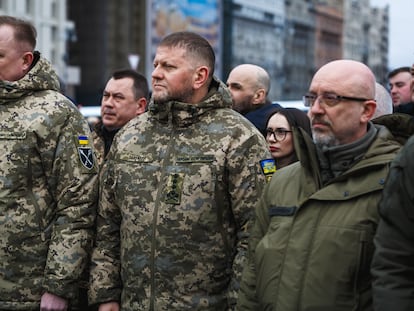Life in Chasiv Yar, the prelude to Bakhmut’s hell
Around 99% of residential buildings and 80% of the houses are damaged or destroyed in the town, which is close to the front where the Wagner Group gained greater prominence
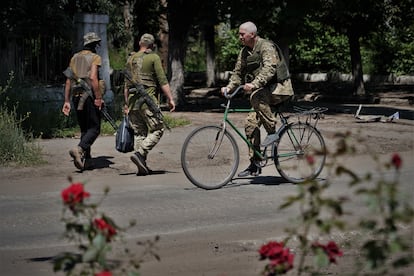

Roses flourish in the flowerbeds of desolate Chasiv Yar. It’s as if someone had been left to care for them. The color of the flowers wins the battle against the undergrowth, which has become rampant in this almost deserted town near the city limits of Bakhmut, which was taken by Russian troops last month. In Chasiv Yar, local troops advanced between 600 and 1,000 meters from the southern and northern flanks, according to Serhiy Cherevaty, the spokesperson for the Ukrainian armed forces in the east of the country, who reported the news on national television.
In the bloody battle of Bakhmut, the Wagner Group of mercenaries played a key role. On Saturday, the mercenaries’ leader Yevgeny Prigozhin launched the biggest challenge to Russian President Vladimir Putin in years, when he started a rebellion that later fizzled out. The few residents who remain in Chasiv Yar — there are just over 1,000 — say that the loss of Bakhmut has not changed their particular hell of daily attacks. “In recent months, the situation has become tougher every day,” says Serhii Chaus, the head of the Chasiv Yar military administration, a position that corresponds to that of wartime mayor. According to Chaus, 99% of residential buildings and 80% of houses are damaged or destroyed.
A downtown square is covered with graffiti of the image of General Valerii Zaluzhnyi, the top commander of the Ukrainian armed forces. Zaluzhnyi has been gaining popularity in recent months. In the graffitied stencil-image, the commander is smiling and making the V for victory sign with his right hand. It’s a touch of optimism in the midst of a dilapidated and ghostly world. “The attacks continue as before, but I cannot give you more details. Only those in charge of the military can comment on these things,” says Chaus as the sound of explosions is heard in the distance.
Bakhmut provides no strategic advantage, at least no more than other towns that have been overlooked by the two armies. But after nearly a year of battle and with thousands of lives lost on both sides, no one wanted to budge. Late last May, spearheaded by mercenaries from the Wagner Group, Moscow seized the remains of the city, which now lies in ruins. One of the main unknowns following Prigozhin’s rebellion on Saturday is what will happen to the Wagner mercenaries, many of whom are ruthless, lack training and were sent into battle as cannon fodder. Meanwhile, in the Bakhmut theater of war, Kyiv is trying to recover lost ground on the surrounding front that extends tens of miles, covering also Chasiv Yar.
When faced with the darkness of the war, any light can brighten the lives of the residents who have remained in Chasiv Yar. “Now it’s summer, we can take care of the garden and it’s easier to survive,” says Natalia, 60. She lives alone and walks to a bread distribution point, oblivious to the column of smoke that is rising behind her after a projectile hit a couple of miles away. Her friend Marina, 57, lives with her son and says that they have learned how to love alongside fear. “No pasarán!” her son shouts in Spanish when he learns the reporter is from Spain. This expression — meaning “They shall not pass” — was popularized by the resistance to Franco’s forces in the Spanish Civil War and is widely known in Ukraine, where it is used to describe the resistance to Russia.
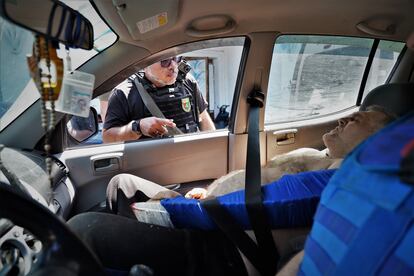
Chasiv Yar was home to 12,000 residents when Russia invaded Ukraine in February last year. Since then, the daily rigors of artillery, missiles and aerial bombardments have not stopped. The last children in the town were evacuated three months ago and the population is around 10% of what it was before the war, that is, a little more than a thousand inhabitants, according to estimates by Chaus. “The situation is permanently difficult” as “there is daily shelling by the Russian Federation, so the city is attacked and destroyed every day. Recently, the number of injuries and deaths among the local population has increased,” he explains.
Many of those who resist in Chasiv Yar are older people, says Chaus. “People who do not have the opportunity or the desire to change their place of residence. It is difficult for them to leave the place where they lived all their lives,” he adds. This is the case of two women who arrive by bicycle to the service point. “Home is home,” says Ludmila, 64, who complains that some take advantage of the chaos to rob houses. “We do not see those responsible, but we do see their consequences,” she says. Next to her, Ira, 53, writes down her comments. They say that the attacks intensify after 1 p.m. Neither of them plans to agree to being evacuated.“Unless the situation worsens,” they add without expressly referring to a possible Russian advance on Chasiv Yar.
With such a small number of inhabitants, evacuations take place little by little. Chaus speaks to a resident who is going to be evacuated after his arm was broken in a shelling. He is being taken out in Chaus’s van, an old ambulance set up as a multipurpose vehicle. Chaus acknowledges that they need “everything”: food, water, medicine, hygiene products… But “we have a large number of volunteers who help us, various organizations and foundations. We contact everyone in case of any need. We know who to turn to, what to buy,” he says.
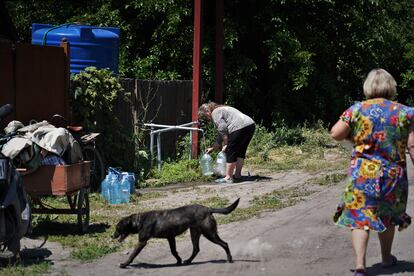
When asked what is it like to be in charge of a city so close to the front lines, he replies: “This is a job where there are no days off. We have not stopped since the beginning of the war.” Indeed, the military administrator travels back and forth to Chasiv Yar due to the difficulties of living there permanently. In any case, “planning is hardly possible; every two minutes something changes,” he adds.
The goal of the Ukrainian counteroffensive is to encircle the Bakhmut front and leave 50,000 Russians inside, explains Mamai, a war nickname taken from a Cossack hero, who is a colonel of the border guards in the area. The reality on the ground, according to the daily reports from Ukrainian authorities, is that achieving this objective is not going to happen in the short term.
Surrounded by several of his men, Mamai drinks coffee next to an armored vehicle at a gas station in Kostiantynivka, a local army logistics enclave some 15 miles from Bakhmut. One of the uniformed men comes out of the store with a bag full of energy drink cans. “Energy for Chasiv Yar!” he proclaims while distributing the drinks among the soldiers. Minutes later, the Ukrainian-made Kozac vehicle — which is used to transport troops and has anti-mine protection — heads towards that town. It travels down secondary roads and paths that meander between poppy fields, where columns of smoke rise from the impact of projectiles.
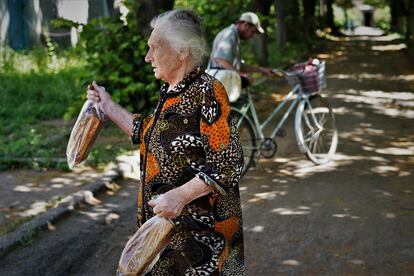
On the streets of Chasiv Yar, it is easier to see the soldiers who have settled into the houses of evacuated citizens than the thousand or so civilians who have remained. Some chat and repair their vehicles. Others wander by bicycle or on foot from one place to another. Some carry bags of groceries. The residents are more visible near the care center, where humanitarian aid is distributed. At that facility, located on the ground floor of a building, they can also charge their cellphones thanks to a generator, connect to the internet, get water, have something to drink and speak to authorities.
The morning passes relatively calmly, without direct attacks on the town center. Several men converse in a lively gathering in the shade of a tree. One of them asks about a little packet that has been found. It is a cream to apply in cases of burns. He keeps it. The presence of the camera disturbs the group. They argue that journalists attract Russian bombs and recall a previous case in which, the day after a report was broadcast on television, a hail of bombs arrived. The sound of an airplane menacingly tears the sky. No one flinches or feels directly threatened. Underneath the General Zaluzhnyi graffiti, there is a caption: “No matter how hard all this may be for us, it certainly won’t be humiliation.”
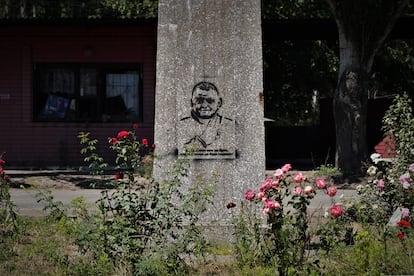
Sign up for our weekly newsletter to get more English-language news coverage from EL PAÍS USA Edition
Tu suscripción se está usando en otro dispositivo
¿Quieres añadir otro usuario a tu suscripción?
Si continúas leyendo en este dispositivo, no se podrá leer en el otro.
FlechaTu suscripción se está usando en otro dispositivo y solo puedes acceder a EL PAÍS desde un dispositivo a la vez.
Si quieres compartir tu cuenta, cambia tu suscripción a la modalidad Premium, así podrás añadir otro usuario. Cada uno accederá con su propia cuenta de email, lo que os permitirá personalizar vuestra experiencia en EL PAÍS.
¿Tienes una suscripción de empresa? Accede aquí para contratar más cuentas.
En el caso de no saber quién está usando tu cuenta, te recomendamos cambiar tu contraseña aquí.
Si decides continuar compartiendo tu cuenta, este mensaje se mostrará en tu dispositivo y en el de la otra persona que está usando tu cuenta de forma indefinida, afectando a tu experiencia de lectura. Puedes consultar aquí los términos y condiciones de la suscripción digital.
More information
Archived In
Últimas noticias
Most viewed
- David King, chemist: ‘There are scientists studying how to cool the planet; nobody should stop these experiments from happening’
- Reinhard Genzel, Nobel laureate in physics: ‘One-minute videos will never give you the truth’
- Oona Chaplin: ‘I told James Cameron that I was living in a treehouse and starting a permaculture project with a friend’
- Mexico completes its trade shift with the entry into force of tariffs on China and countries without trade agreements
- Sinaloa Cartel war is taking its toll on Los Chapitos

